Cómo aplicar microcemento en escaleras: paso a paso y consejos
El microcemento es el revestimiento decorativo por excelencia para pisos y paredes. De hecho es muy frecuente observar pavimentos continuos y paredes de microcemento en todo tipo de locales comerciales y negocios. Pero también en el ámbito doméstico, donde este recubrimiento ha ganado una popularidad estelar en la renovación de baños y cocinas gracias a los acabados impermeables y antideslizantes que ofrece el microcemento.
Una versatilidad a la que hay que sumar las escaleras de microcemento, un elemento decorativo diferenciador que cada vez más profesionales y particulares tienen en cuenta por su estética moderna, la continuidad que aporta al no necesitar de juntas de dilatación y, sobre todo, su extraordinaria funcionalidad respecto a otros materiales.
Ya que no hay que olvidar que aunque las escaleras de microcemento están diseñadas para facilitar y agilizar el acceso a los diferentes pisos del edificio en cuestión, no deja de ser un elemento de diseño potente a nivel visual por su carácter de ruptura.
En el presente artículo vamos a abordar todo lo que tienes que saber de las escaleras de microcemento: ventajas, tipos, colores más adecuados, cómo hacer correctamente una escalera de microcemento y una serie de consejos para que te conviertas en un auténtico experto en la materia.
Ventajas de las escaleras de microcemento
Las escaleras son uno de los lugares más transitados de las viviendas. Se utilizan varias veces al día, con el consecuente desgaste que ello supone. Con el microcemento no solo se aporta un toque de modernidad a la escalera, sino también durabilidad y una gran resistencia al desgaste por abrasión y al tránsito.
Sea cual sea la forma de la escalera, tanto si es vieja como de nueva construcción, las escaleras revestidas con microcemento son imponentes y atraen la mirada de cualquiera. Pero hay muchos más motivos por los que se han convertido en una tendencia decorativa de plena actualidad.
A continuación explicamos las principales ventajas que han elevado a las escaleras de microcemento a lo más alto.
¿Por qué las escaleras de microcemento se han convertido en una tendencia decorativa? A continuación explicamos los principales beneficios que han elevado a las escaleras de microcemento a lo más alto.
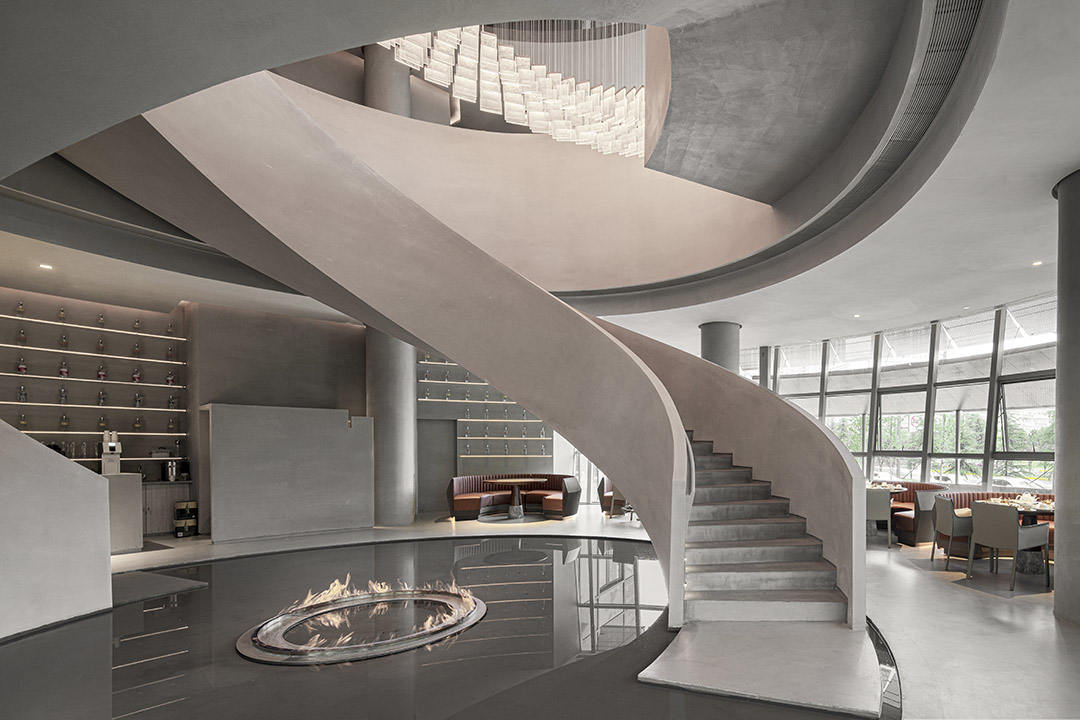
1. Las escaleras de microcemento promueven la continuidad
Las escaleras revestidas con microcemento tienen cada día más seguidores por muchas razones, especialmente porque no necesitan juntas de dilatación a diferencia de las escaleras de madera o parquet, por ejemplo. Un valor agregado ya que las escaleras de microcemento fomentan la continuidad de la propia escalera y, sobre todo, del espacio en el que se encuentran.
Todos los elementos (escalera, piso, paredes, techo) forman parte de un todo al quedar integrados a la perfección. Una apariencia de continuidad absoluta que puede ir un paso más allá si el color de la escalera va en consonancia con el del pavimento.
2.Olvida las obras con las escaleras de microcemento
El microcemento es un revestimiento decorativo de gran adherencia que se aplica directamente sobre el material existente como mármol o concreto. Una ventaja competitiva que te permite renovar las escaleras con microcemento sin necesidad de obras y escombros en apenas unas horas, con el ahorro de tiempo y costes que esto conlleva.
3. Fácil limpieza de las escaleras de microcemento
Las escaleras pequeñas usualmente no causan muchos problemas en términos de limpieza. Pero, ¿qué pasa con esas escaleras interminables que conectan pisos y pisos y que te dan vértigo solo de mirarlas?
Las escaleras de microcemento son muy prácticas, ya que su limpieza es de lo más sencilla al tratarse de una superficie continua sin juntas que facilita y agilita el proceso de limpieza de cada escalón. Con agua y jabón neutro, es más que suficiente.
4. Las escaleras de microcemento son muy resistentes
Si hay un elemento diferenciador de las escaleras de microcemento, es su durabilidad. Se mantendrán en perfecto estado aunque pasen los años gracias a las excelentes resistencias de las que goza, especialmente al tránsito, impacto y abrasión. El microcemento Topciment para escaleras es un material que soporta todo tipo de golpes.
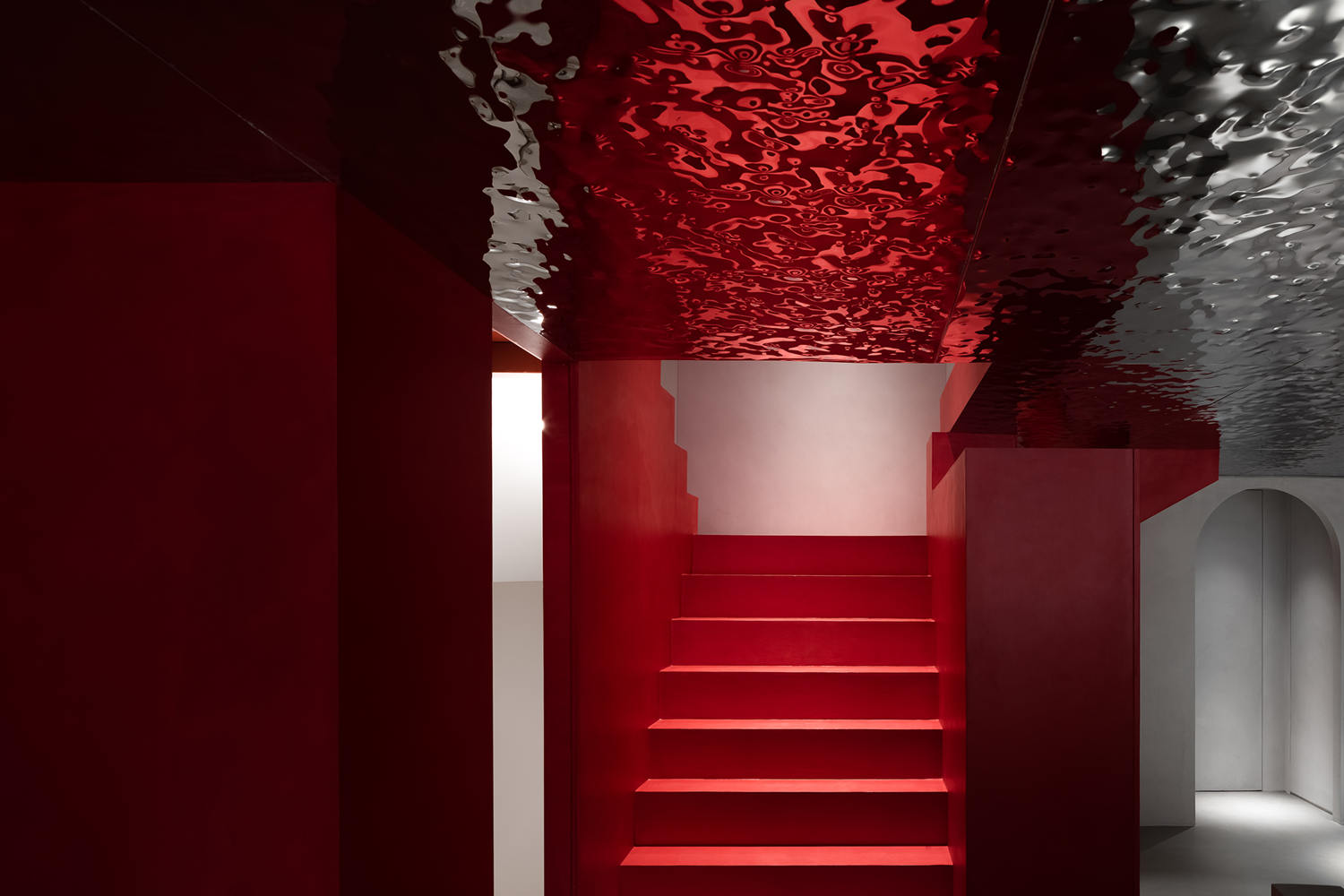
5. El microcemento en escaleras no afecta a la carga estructural
Hay que destacar el ínfimo grosor del microcemento (entre 2 y 3 milímetros). Esto permite que revestir las escaleras con microcemento no afecte de ninguna de las maneras a la carga estructural.
6. Escaleras de microcemento para interiores y exteriores
Las escaleras de microcemento son un elemento arquitectónico muy polivalente que se utiliza sobre todo en el diseño de interiores por la sensación de estabilidad, amplitud del espacio y limpieza que ofrece. No obstante, cada vez se ha puesto más de moda revestir escaleras con microcremento también en exteriores, por la elegancia, majestuosidad y presencia que destilan.
7. Escaleras de microcemento con acabado antiderrapante
Gracias a nuestros microcementos Microdeck, la escalera de microcemento será un espacio seguro y libre de resbalones y caídas, ya que son tipos de microcemento alisado que garantizan ese acabado antideslizante. Asimismo, por si el aplicador opta por otro tipo de microcemento, en Topciment contamos nuestro barniz Topsealer WT Anti Slip que le da a la escalera de microcemento dicho carácter antideslizante.
Tipos de escaleras de microcemento
Las posibilidades de diseño que permite el microcemento para revestir escaleras son ilimitadas. En la categorización que nosotros vamos a hacer, hemos tenido en cuenta dos factores. En primer lugar, si los peldaños de las escaleras de microcemento se encuentran entre las paredes o no y el tipo de contrahuellas de las mismas.
Con esta diferenciación, nos encontramos las siguientes escaleras de microcemento: escaleras de microcemento cerradas con dos paredes, escaleras de microcemento cerradas con una pared, escaleras de microcemento cerradas sin paredes, escaleras de microcemento abiertas con dos paredes, escaleras de microcemento abiertas con una pared, escaleras de microcemento abiertas sin paredes, escaleras de microcemento empotradas en una pared, escaleras de microcemento empotradas sin paredes y escaleras de microcemento con soporte central.
¿Qué microcemento y color usar para las escaleras?
Aunque el gris es el color más demandado para revestir con microcemento las escaleras, se pueden aplicar todo tipo de colores con los que dotar de un elemento diferenciador a la decoración de tu casa o negocio. En Topciment, contamos con un amplio catálogo de colores de microcemento para escaleras. Desde colores neutros para un diseño más minimalista e industrial a colores más vivos si se busca una decoración más arriesgada.
En cuanto al tipo de microcemento, nuestros expertos recomiendan el microcemento de terminación Microdeck para revestir las escaleras. En Topciment hemos desarrollado tres tipos de Microdeck: Sttandard Microdeck (microcemento bicomponente tradicional), y Evoluttion Microdeck (microcemento monocomponente).
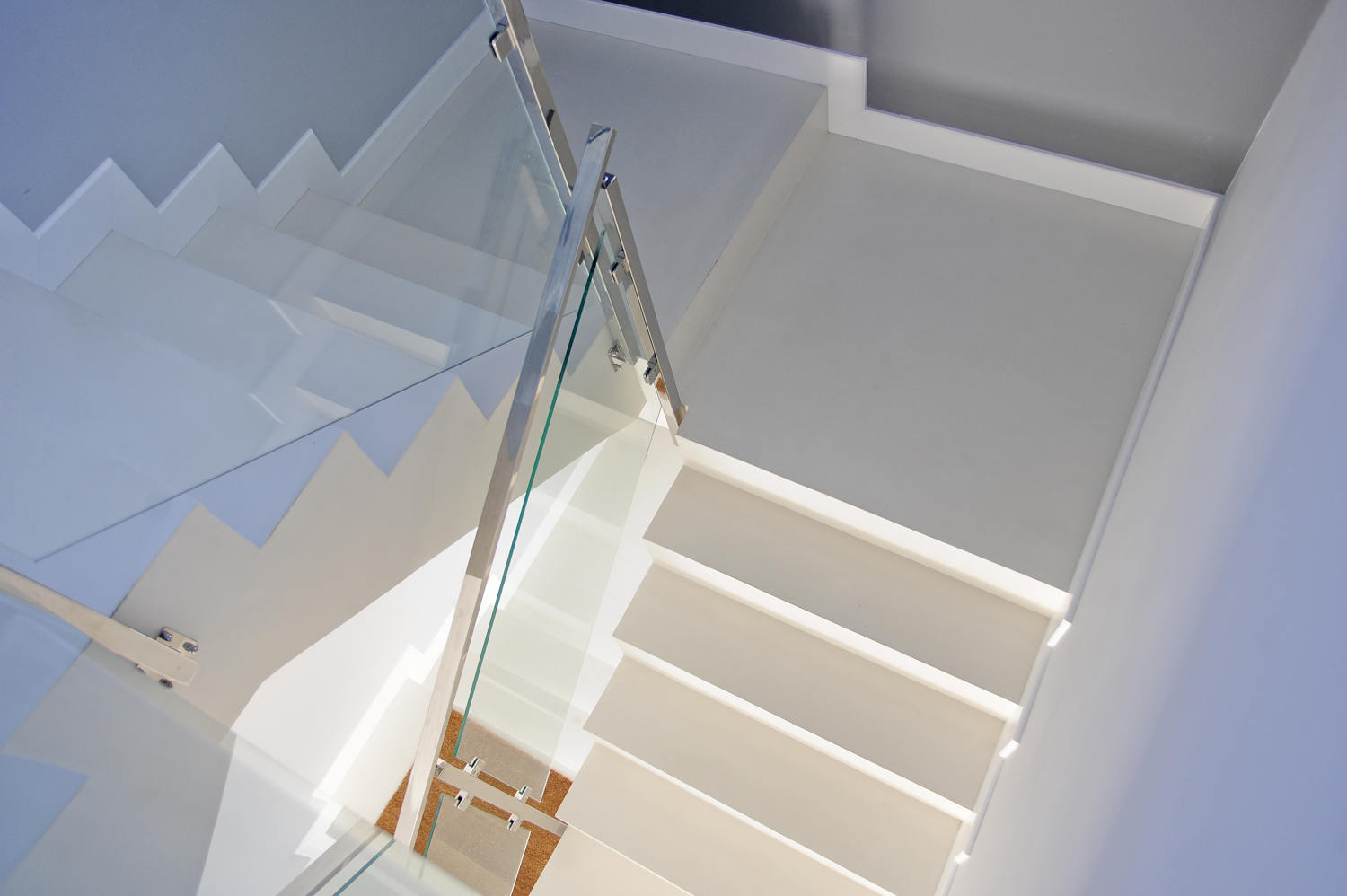
¿Sobre qué materiales se puede aplicar el microcemento en escaleras?
Una de las cualidades del microcemento es que puede ser aplicado sobre multitud de soportes de lo más variados. Esta versatilidad es lo que marca la diferencia en comparación con otros revestimientos decorativos del mercado. De esta manera, se puede aplicar el microcemento sobre una escalera de baldosas, mármol, granito y cemento, entre otros materiales.
Renovarás de manera rápida, fácil y sin obras tu escalera recubriéndola con un par de milímetros de microcemento. Una capa que al ser tan fina no afectará en absoluto a la carga estructural de la escalera. La superficie quedará completamente estable y continua en una sola operación, modernizando así un elemento que volverá a encajar con el diseño interior del resto de la estancia.
Escaleras de microcemento y madera
No obstante, hay un material sobre el cual desaconsejamos aplicar microcemento: la madera. ¿Por qué? Muy simple. La madera es un material que puede contraerse y dilatarse y, por consiguiente, producir microfisuras que afectarían al nuevo soporte.
Otro de los principales problemas de aplicar microcemento en una escalera de madera es que, si la madera en cuestión no está del todo curada, puede desprender resinas. Esto provocaría que el nuevo revestimiento de microcemento copiara la veta de la madera.
Por otro lado, si tienes unas escaleras de madera MDF, sí se puede aplicar microcemento en los escalones.
¿Escalera de microcemento exterior? ¡Sí rotundo!
Los microcementos que hemos desarrollado en Topciment pueden aplicarse tanto en escaleras de interior como en escaleras de exterior. Con el uso de nuestros barnices Topsealer la escalera resistirá a los efectos de los rayos del sol así como al agua de la lluvia.
Otra de las ventajas de nuestros microcementos para escaleras exteriores es que proporcionan un acabado antideslizante, haciéndolas muy seguras ante posibles caídas y resbalones.
Por un lado tenemos Microdeck, que puede ser aplicado con la técnica fresco sobre fresco y que es uno de los microcementos más utilizados para revestir escaleras en espacios exteriores. Está disponible como microcemento bicomponente y microcemento monocomponente. En los dos casos, posee buena capacidad antideslizante y muy buenas resistencias mecánicas y químicas.
Por el otro lado está Sttandard Microstone, nuestro microcemento bicomponente creado en especial para revestir superficies de exterior. A diferencia de Microdeck, cuenta con un nivel de antideslizamiento superior. En cuanto a la estética, es el más indicado para lograr un acabado más rústico y tosco.
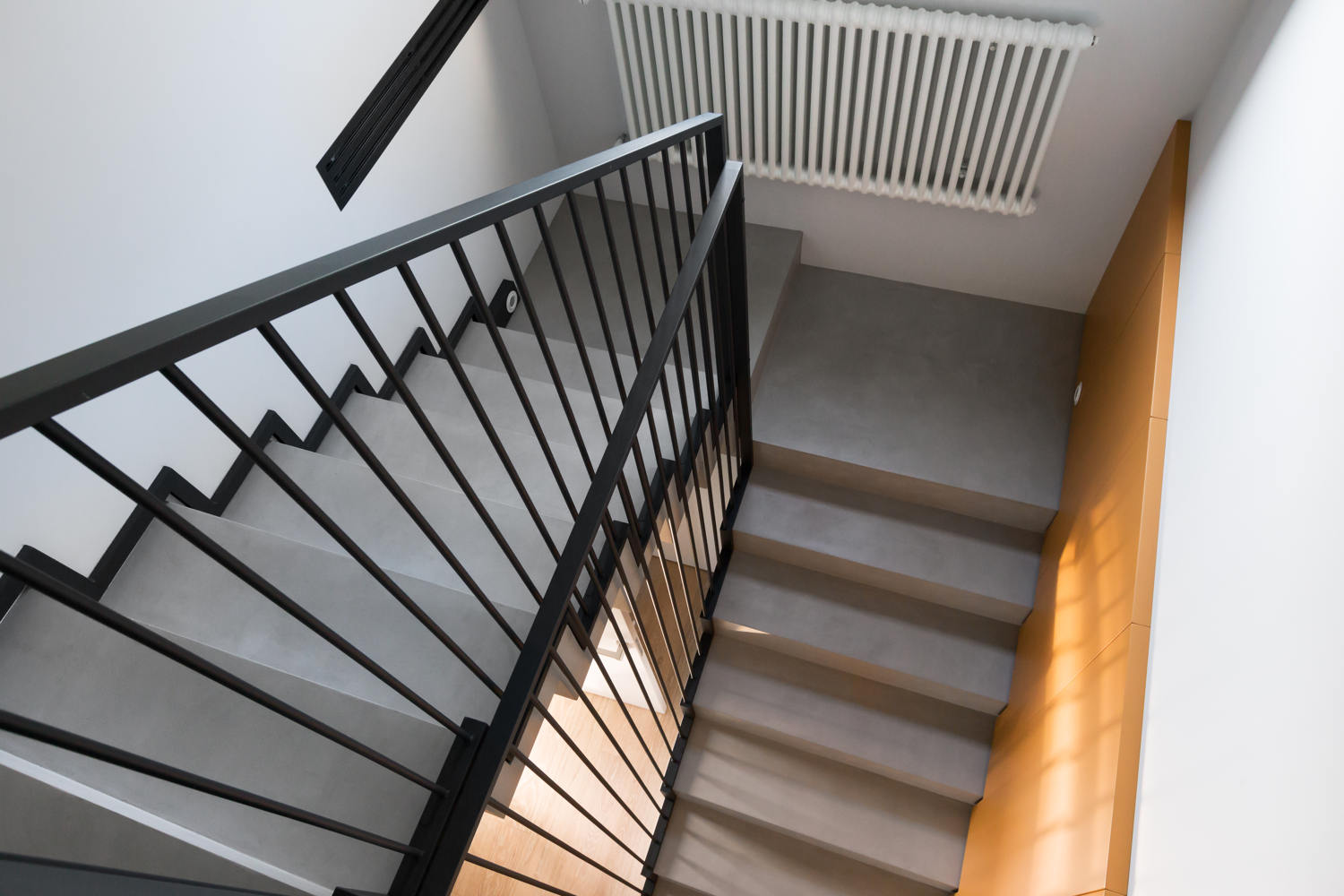
Cómo aplicar microcemento en escaleras: 8 pasos
Lo primero que hay que tener en cuenta a la hora de aplicar microcemento en una escalera, es que este proceso solo puede ser llevado a cabo por un profesional experimentado. Ya que revestir con microcemento una escalera requiere de una técnica de aplicación avanzada para obtener el resultado deseado. Una serie de particularidades que hay que tener en cuenta y que solo un aplicador formado será capaz de garantizar.
Toma nota de los 8 pasos a seguir en las escaleras revestidas con microcemento.
1. Evaluar estado del soporte
Hay que analizar el estado del soporte existente en las escaleras antes de aplicar microcemento.Ya que si el soporte que va a hacer de base a la escalera de microcemento no se encuentra en óptimo estado, podrían acabar apareciendo todo tipo de grietas o defectos. Por eso es tan importante contar con un buen profesional, que sabrá evaluar correctamente la calidad del soporte.
2. Imprimación de la escalera de microcemento
Una vez nos aseguremos que el soporte está en buen estado, el segundo paso para hacer una escalera de microcemento es colocar el primer o promotor de adherencia.
3. Nivelar los peldaños de la escalera de microcemento
El tercer paso para hacer una escalera de microcemento consiste en nivelar y proteger los escalones. De esta forma se previenen roturas y desgastes futuros al eliminar cualquier irregularidad que pueda haber.
4. Aplicar primera capa microcemento Microbase en la escalera
El cuarto paso primera capa de Microbase sin pigmento. Una vez hecho, se lijaría.
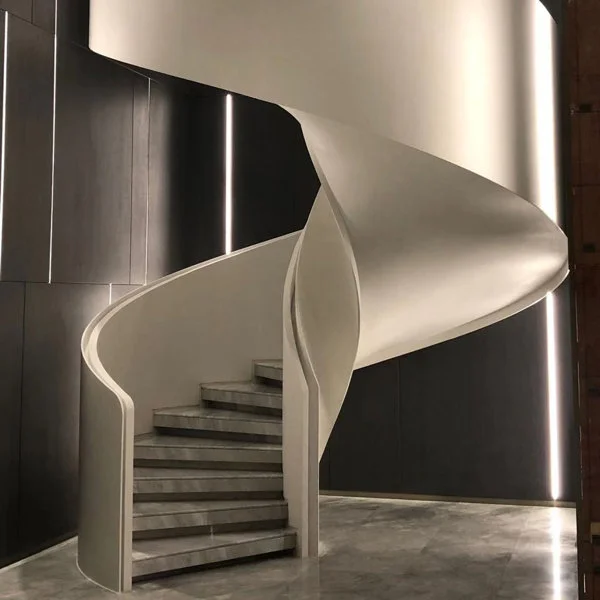
5. Aplicar segunda capa de microcemento Microbase en la escalera
El quinto paso de aplicación en escaleras de microcemento se trata de aplicar una segunda capa de Microbase, en este caso con pigmento. Se tiene que repetir el procedimiento y lijado del paso anterior.
6. Aplicar primera capa microcemento Microdeck en la escalera
El sexto paso para aplicar el microcemento en escaleras es una primera capa delgada de Microdeck con color. Una vez seque la capa habrá que lijar la superficie.
7. Aplicar segunda capa de microcemento Microdeck en la escalera
El sexto paso para hacer escaleras de microcemento es aplicar la segunda capa de Microdeck. En cuanto seque será necesario lijar la superficie.
8. Sellar y proteger la escalera de microcemento
El último paso de la aplicación del microcemento en escaleras es uno de los más importantes, ya que se trata de proteger el revestimiento y que su estado óptimo se prolongue en el tiempo. Para ello, en Topciment aconsejamos aplicar dos manos del barniz acrílico Presealer y otras dos manos de uno de nuestros barnices de poliuretano, especialmente Topsealer WT One Coat .
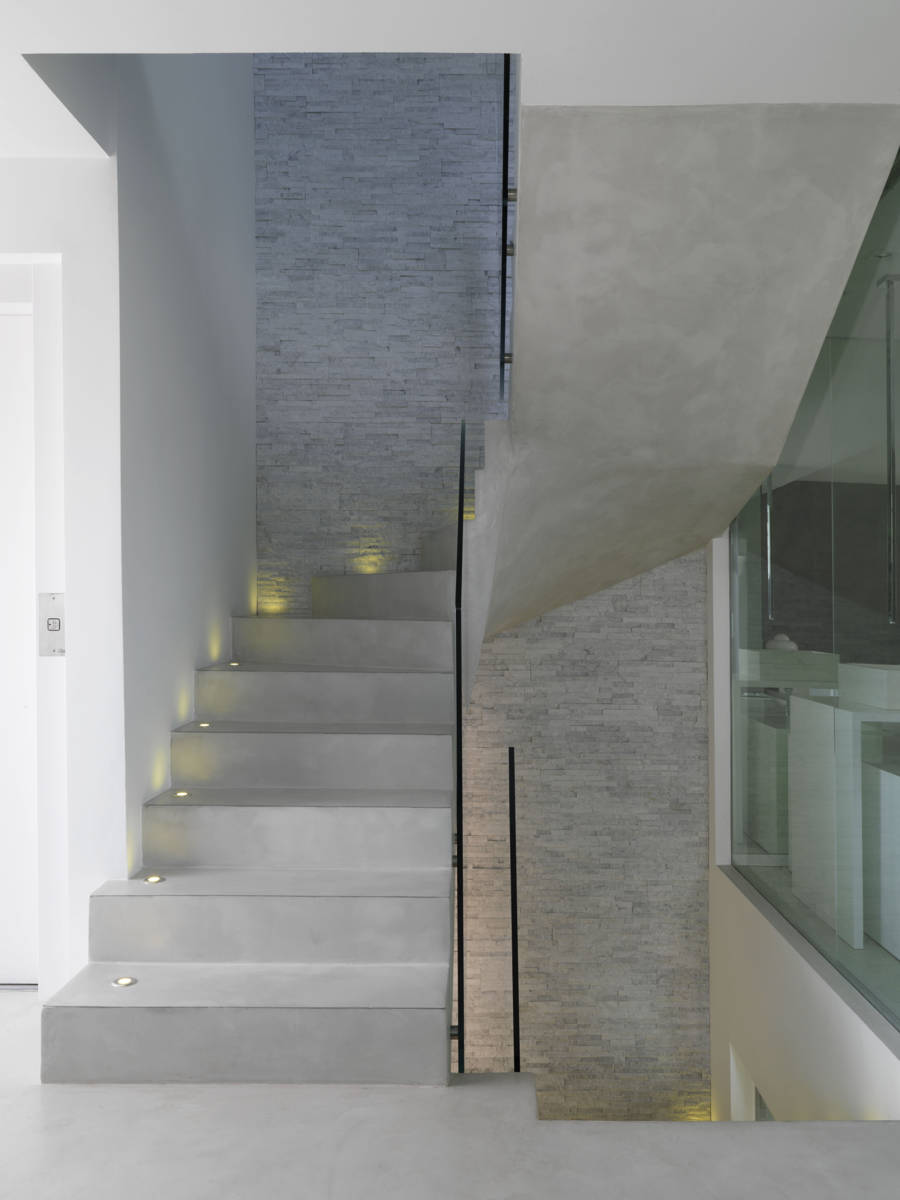
con el piso también revestido con microcemento Topciment.
3 tips para aplicar microcemento en escaleras
Como se ha comentado con anterioridad, no todo el mundo está capacitado para realizar escaleras de microcemento, solo aplicadores profesionales con años de experiencia debido a la complejidad que entraña.
Estos son los tres consejos principales que hay que tener muy presentes a la hora de hacer escaleras de microcemento:
1. Proteger con perfil de aluminio los bordes de la escalera de microcemento
Las esquinas o bordes de los peldaños de las escaleras de microcemento son, sin duda alguna, la zona que más expuesta a todo tipo de rozaduras y golpes. Por ello, como fabricantes aconsejamos aplicar cantoneras o perfiles de aluminio . Complementos que pueden quedar ocultos a la vista (aunque nosotros recomendamos dejarlos visibles porque aportan un punto de elegancia) y que protegerán mejor y por más tiempo las escaleras de microcemento, evitando así que se produzcan roturas o desgastes.
2. Bordes de la escalera de microcemento mínimamente redondeados
Aunque se puede dejar que el escalón de la escalera de microcemento tenga 90 grados, es recomendable que los cantos estén redondeados aunque sea mínimamente. Siguiendo este consejo y "cortando" los bordes de la futura escalera de microcemento, se evitan los despostillados o golpes ya que el impacto sobre la escalera de microcemento es menor.
3. Malla de fibra de vidrio sí o sí en una escalera de microcemento
Aunque algunos aplicadores no siempre colocan una malla de fibra de vidrio en la capa base del microcemento, en Topciment somos partidarios de hacerlo siempre. Gracias a la malla logramos reforzar la escalera de microcemento
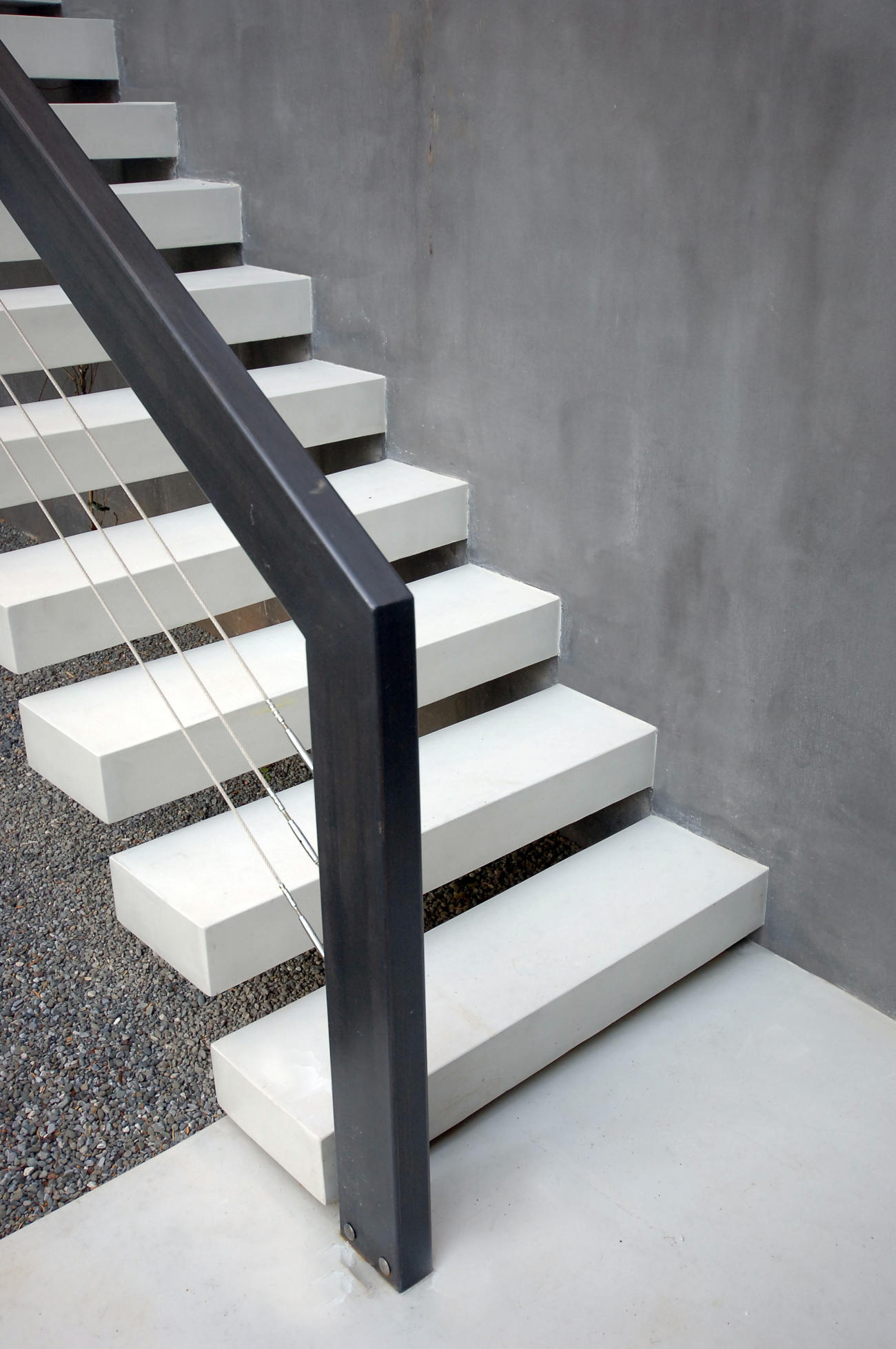
Cómo mantener la escalera de microcemento en estado óptimo
Como se ha explicado con anterioridad, la escalera de microcemento es muy resistente, por lo que no necesita de cuidados exhaustivos para mantenerse en buen estado.
Nosotros recomendamos limpiarla una vez a la semana con un detergente neutro o utilizar nuestros limpiadores para profesionales de la gama Ecoclean. El uso de productos corrosivos dañaría al nuevo revestimiento.
Además, también es muy aconsejable aplicar una cera cada cuatro o seis meses.Con este producto se renueva la capa protectora del microcemento de la escalera y también su brillo. Nosotros hemos diseñado la familia Ceraciment.
Precio de la escalera de microcemento
El precio de una escalera de microcemento no varía en comparación al coste de revestir un pavimento o una pared. La dimensión de la superficie, medida en metros cuadrados, es lo que manda. Además hay elementos como la complejidad de la obra o la calidad de los materiales que intervienen en el coste final.
Aunque sí es cierto que hay algunos aplicadores que toman en cuenta las huellas y contrahuellas que tiene la escalera para determinar un precio final. Lo que puede incrementar el costo un poco.
Aproximadamente, el precio de una escalera de microcemento está entre 60 y 100 euros el metro cuadrado.
Suscríbete a nuestro boletín informativo
Recibe en tu email consejos para la aplicación y cuidado del microcemento, las últimas tendencias y novedades de los productos de Topciment.




